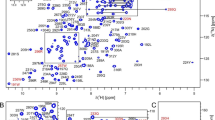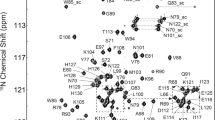Abstract
Lysostaphin family endopeptidases, produced by Staphylococcus genus, are zinc-dependent enzymes that cleave pentaglycine bridges of cell wall peptidoglycan. They act as autolysins to maintain cell wall metabolism or as toxins and weapons against competing strains. Consequently, these enzymes are compelling targets for new drugs as well as are potential antimicrobial agents themselves against Staphylococcus pathogens, which depend on cell wall to retain their immunity against antibiotics. The rapid spread of methicillin and vancomycin-resistant Staphylococcus aureus strains draws demand for new therapeutic approaches. S. aureus gene sa0205 was found to be implicated in resistance to vancomycin and synthesis of the bacteria cell wall. The gene encodes for a catalytic domain of a lysostaphin-type endopeptidase. We aim to obtain the structure of the Sa0205 catalytic domain, the first solution structure of the catalytic domain of the lysostaphin family enzymes. In addition, we are to investigate the apparent binding of the second zinc ion, which has not been previously reported for the enzyme group. Herein, we present the backbone and side chain resonance assignments of Sa0205 endopeptidase catalytic domain in its one and two zinc-bound forms.


Similar content being viewed by others
References
Firczuk M, Mucha A, Bochtler M (2005) Crystal structures of active LytM. J Mol Biol 354(3):578–590
Hafsa NE, Arndt D, Wishart DS (2015) CSI 3.0: a web server for identifying secondary and super-secondary structure in proteins using NMR chemical shifts. Nucl Acid Res 43:W370–W377
Holmes NE, Howden BP (2014) What’s new in the treatment of serious MRSA infection? Curr Opin Infect Dis 27(6):471–478
Kumar JK (2008) Lysostaphin: an antistaphylococcal agent. Appl Microbiol Biotechnol 80(4):555–561
Osipovitch DC, Griswold KE (2015) Fusion with a cell wall binding domain renders autolysin LytM a potent anti-Staphylococcus aureus agent. FEMS Microbiol Lett 362(2):1–7
Permi P, Annila A (2004) Coherence transfer in proteins. Prog Nucl Magn Reson Spectr 44:97–137
Pietiäinen M, François P, Hyyryläinen HL, Tangomo M, Sass V, Sahl HG, Schrenzel J, Kontinen VP (2009) Transcriptome analysis of the responses of Staphylococcus aureus to antimicrobial peptides and characterization of the roles of vraDE and vraSR in antimicrobial resistance. BMC Genom 10:429
Sattler M, Schleucher J, Griesinger C (1999) Heteronuclear multidimensional NMR experiments for the structure determination of proteins in solution employing pulsed field gradients. Prog Nucl Magn Reson Spectr 34:93–158
Schneewind O, Fowler A, Faull KF (1995) Structure of the cell wall anchor of surface proteins in Staphylococcus aureus. Science 268(5207):103–106
Szweda P, Schielmann M, Kotlowski R, Gorczyca G, Zalewska M, Milewski S (2012) Peptidoglycan hydrolases-potential weapons against Staphylococcus aureus. Appl Microbiol Biotechnol 96:1157–1174
Thumm G, Götz F (1997) Studies on prolysostaphin processing and characterization of the lysostaphin immunity factor (Lif) of Staphylococcus simulans biovar staphylolyticus. Mol Microbiol 23:1251–1265
Acknowledgements
This work was supported by the Academy of Finland Grant 288235 to PP. Vytas Raulinaitis acknowledges the Centre for International Mobility CIMO and Helsinki Graduate Program in Biotechnology and Molecular Biology.
Author information
Authors and Affiliations
Corresponding author
Rights and permissions
About this article
Cite this article
Raulinaitis, V., Tossavainen, H., Aitio, O. et al. 1H, 13C and 15N resonance assignments of the new lysostaphin family endopeptidase catalytic domain from Staphylococcus aureus . Biomol NMR Assign 11, 69–73 (2017). https://doi.org/10.1007/s12104-016-9722-7
Received:
Accepted:
Published:
Issue Date:
DOI: https://doi.org/10.1007/s12104-016-9722-7




